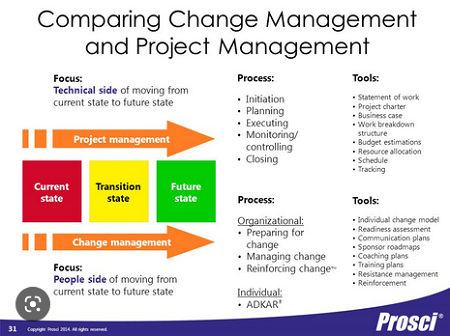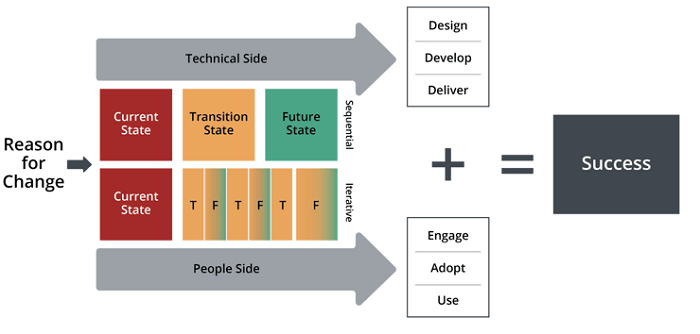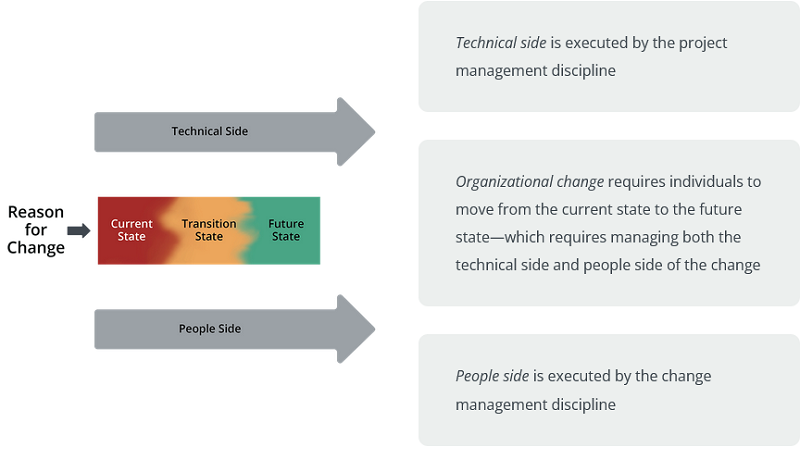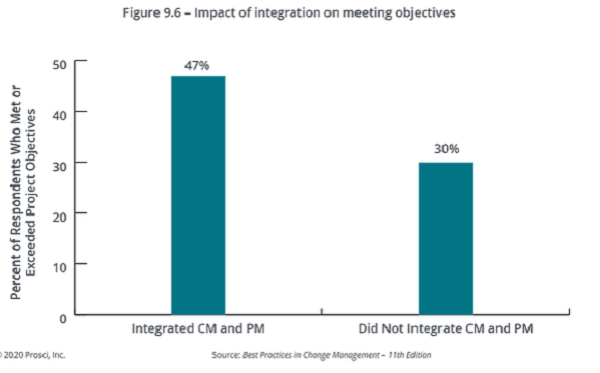(Successful Change Management -11 Elements Cont. 3)
9. Integrate change management with project management and improvement processes (change management has more focus on the people side and less on the technical when compared with project management; both are needed for initiatives to be successful, and need to be integrated from the start; some basic details about change management and project management (see table below)
| Change management |
Project management |
|
| Definitions |
The application of structure, process and tools which lead the people side of change to achieve a desired outcome (such as ROI on a project) | The use of specific knowledge, skill, tools and techniques to deliver something of value to people |
| Intent |
To ensure that impacted employees embrace.and use the solution(s) associated with a change | To ensure that the solution is designed, developed and delivered effectively |
| Focus |
Stakeholders (including staff) impacted by a project solution or initiative (those who must adopt and use the change) | Task and activities required to create & implement the technical solutions associated with a change |
| Scaling factor |
Characteristics of the change, attributes of the impacted organisation, and degree of 'people change' required | Complexity and degree of technical change associated with the project or initiative |
| Process |
phase 1 - prepare approach phase 2 - manage change phase 3 - sustain outcomes (for more detail, see elsewhere in the Knowledge Base) |
-stakeholder performance - team performance - development approach & life-cycle performance - planning, performance - project work performance - delivery performance - measurement performance - uncertainty performance, etc |
| Success measurement |
Measurement focuses on elements of the people side of change, including: - speed of adoption impact on staff - ultimate utilisation by impacted staff - proficiency of impacted staff - achievements of results & outcomes (these depend on individuals adopting the change, eg people-dependent contribution) |
Measurement focuses on technical side of change element, primarily: - on time - on budget - meets technical requirements - achievement of results and outcomes (projects are considered successful at launch or 'go-live', despite the organisational benefits not yet being realised |
| Who practis es |
Involves a coordinated system of support throughout the organisation, not just change management practitioners: - executives and senior managers who sponsor the change - people managers and supervisors who coach and support direct reports through the change |
Typically practised by a project manager and project team assigned to a specific project or initiative: - project managers who manage the task, activities & resources to execute the technical side - project teams comprising subject matter experts and representatives from the organisation (source: Tim Creasey, 2023a) |

(source: Prosci, 2023j)
Change management (people side) and project management (technical side) are complementary disciplines, ie

(source: Prosci, 2023j)
Another way of explaining this

(source: Prosci, 2023k)
"...if the individuals involved in addressing the technical and people side of change work together collaboratively, they will deliver a more successful change..."
Prosci, 2023j
Integrating change management and project management contributes to an increase in change success by
- creating a shared objective (to improve the organisation's performance by successfully implementing change that delivers the intended results and outcomes)- enabling a more proactive approach (the integration results in being able
"...to proactively identify and mitigate risks, anticipate and address obstacles and resistance, and build commitment to an adoption of the change..."
Prosci, 2023j
- improving sequencing and alignment (integrating technical and people activities helps take right actions at the right time so that people are ready and able to adopt the change and produce successful outcomes)
- enhancing information exchange (integration improves the flow of information during the life of the project.
"...early in the project lifecycle, the integrated approach helps ensure that the impacted people receive information they need to understand why the change is needed and the personal benefits from adopting the change. Later in the project life-cycle, the integrated approach helps ensure that the project team receives effective feedback on adoption, usage and functionality of the solution being implemented..."
Prosci, 2023j
